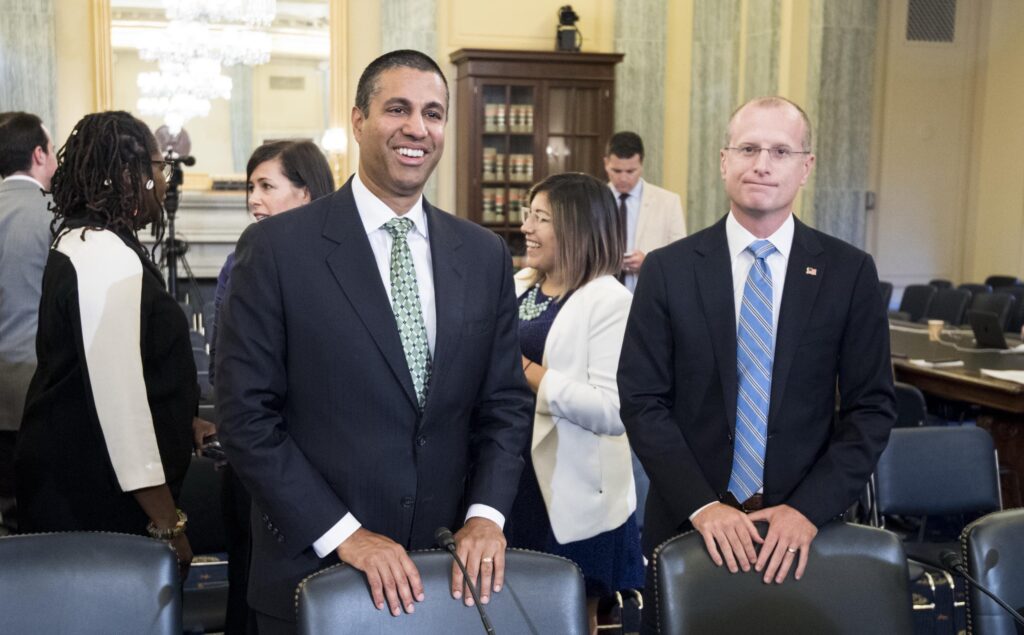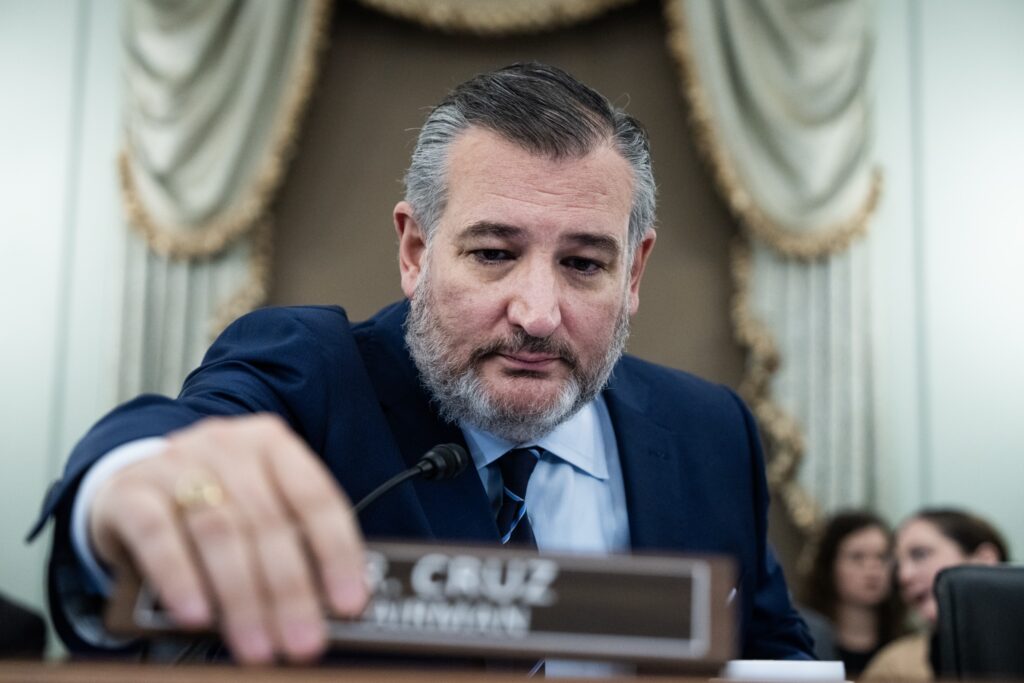Pai’s return as CTIA lobbyist fuels industry-wide battle over spectrum rights.
Ajit Pai, former chairman of the Federal Communications Commission, during a Senate Commerce Committee hearing on Wednesday, April 9, 2025. Credit: Getty Images | Bloomberg
Ajit Pai is back on the telecom policy scene as chief lobbyist for the mobile industry, and he has quickly managed to anger a coalition that includes both cable companies and consumer advocates.
Pai was the Federal Communications Commission chairman during President Trump’s first term and then spent several years at private equity firm Searchlight Capital. He changed jobs in April, becoming the president and CEO of wireless industry lobby group CTIA. Shortly after, he visited the White House to discuss wireless industry priorities and had a meeting with Brendan Carr, the current FCC chairman who was part of Pai’s Republican majority at the FCC from 2017 to 2021.
Pai’s new job isn’t surprising. He was once a lawyer for Verizon, and it’s not uncommon for FCC chairs and commissioners to be lobbyists before or after terms in government.
Pai’s move to CTIA means he is now battling a variety of industry players and advocacy groups over the allocation of spectrum. As always, wireless companies AT&T, Verizon, and T-Mobile want more spectrum and the exclusive rights to use it. The fight puts Pai at odds with the cable industry that cheered his many deregulatory actions when he led the FCC.
Pai wrote a May 4 op-ed in The Wall Street Journal arguing that China is surging ahead of the US in 5G deployment and that “the US doesn’t even have enough licensed spectrum available to keep up with expected consumer demand.” He said that Congress must restore the FCC’s lapsed authority to auction spectrum licenses, and auction off “at least 600 megahertz of midband spectrum for future 5G services.”
“During the first Trump administration, the US was determined to lead the world in wireless innovation—and by 2021 it did,” Pai wrote. “But that urgency and sense of purpose have diminished. With Mr. Trump’s leadership, we can rediscover both.”
Pai’s op-ed drew a quick rebuke from a group called Spectrum for the Future, which alleged that Pai mangled the facts.
“Mr. Pai’s arguments are wrong on the facts—and wrong on how to accelerate America’s global wireless leadership,” the vaguely named group said in a May 8 press release that accused Pai of “stunning hypocrisy.” Spectrum for the Future said Pai is wrong about the existence of a spectrum shortage, wrong about how much money a spectrum auction could raise, and wrong about the cost of reallocating spectrum from the military to mobile companies.
“Mr. Pai attributes the US losing its lead in 5G availability to the FCC’s lapsed spectrum auction authority. He’d be more accurate to blame his own members’ failure to build out their networks,” the group said.
Big Cable finds allies
Pai’s op-ed said that auctioning 600 MHz “could raise as much as $200 billion” to support other US government priorities. Spectrum for the Future called this an “absurd claim” that “presumes that this auction of 600 MHz could approach the combined total ($233 billion) that has been raised by every prior spectrum auction (totaling nearly 6 GHz of bandwidth) in US history combined.”
The group also said Pai “completely ignores the immense cost to taxpayers to relocate incumbent military and intelligence systems out of the bands CTIA covets for its own use.” Spectrum for the Future didn’t mention that one of the previous auctions, for the 3.7–3.98 GHz band, netted over $81 billion in winning bids.
So who is behind Spectrum for the Future? The group’s website lists 18 members , including the biggest players in the cable industry. Comcast, Charter, Cox, and lobby group NCTA-The Internet & Television Association are all members of Spectrum for the Future. (Disclosure: The Advance/Newhouse Partnership, which owns 12 percent of Charter, is part of Advance Publications, which owns Ars Technica parent Condé Nast.)
When contacted by Ars, a CTIA spokesperson criticized cable companies for “fighting competition” and said the cable firms are being “disingenuous.” Charter and Cox declined to answer our questions about their involvement in Spectrum for the Future. Comcast and the NCTA didn’t respond to requests for comment.
The NCTA and big cable companies are no strangers to lobbying the FCC and Congress and could fight for CBRS entirely on their own. But as it happens, some consumer advocates who regularly oppose the cable industry on other issues are on cable’s side in this battle.
With Spectrum for the Future, the cable industry has allied not just with consumer advocates but also small wireless ISPs and operators of private networks that use spectrum the big mobile companies want for themselves. Another group that is part of the coalition represents schools and libraries that use spectrum to provide local services.
For cable, joining with consumer groups, small ISPs, and others in a broad coalition has an obvious advantage from a public relations standpoint. “This is a lot of different folks who are in it for their own reasons. Sometimes that’s a big advantage because it makes it more authentic,” said Harold Feld, senior VP of consumer advocacy group Public Knowledge, which is part of Spectrum of the Future.
In some cases, a big company will round up nonprofits it has donated to make a show of broad public support for one of the company’s regulatory priorities—like a needed merger approval. That’s not what happened here, according to Feld. While cable companies probably provided most of the funding for Spectrum for the Future, the other members are keenly interested in fighting the wireless lobby over spectrum access.
“There’s a difference between cable being a tentpole member and this being cable with a couple of friends on the side,” Feld told Ars. Cable companies “have the most to lose, they have the most initial resources. But all of these other guys who are in here, I’ve been on these calls, they’re pretty active. There are a lot of diverse interests in this, which sometimes makes it easier to lobby, sometimes makes it harder to lobby because you all want to talk about what’s important to you.”
Feld didn’t help write the group’s press release criticizing Pai but said the points made are “all things I agree with.”
The “everybody but Big Mobile” coalition
Public Knowledge and New America’s Open Technology Institute (OTI), another Spectrum for the Future member, are both longtime proponents of shared spectrum. OTI’s Wireless Future Project director, Michael Calabrese, told Ars that Spectrum for the Future is basically the “everybody but Big Mobile” wireless coalition and “a very broad but ad hoc coalition.”
While Public Knowledge and OTI advocate for shared spectrum in many frequency bands, Spectrum for the Future is primarily focused on one: the Citizens Broadband Radio Service (CBRS), which spans from 3550 MHz to 3700 MHz. The CBRS spectrum is used by the Department of Defense and shared with non-federal users.
CBRS users in the cable industry and beyond want to ensure that CBRS remains available to them and free of high-power mobile signals that would crowd out lower-power operations. They were disturbed by AT&T’s October 2024 proposal to move CBRS to the lower part of the 3 GHz band, which is also used by the Department of Defense, and auction existing CBRS frequencies to 5G wireless companies “for licensed, full-power use.”
The NCTA told the FCC in December that “AT&T’s proposal to reallocate the entire 3 GHz band is unwarranted, impracticable, and unworkable and is based on the false assertion that the CBRS band is underutilized.”
Big mobile companies want the CBRS spectrum because it is adjacent to frequencies that are already licensed to them. The Department of Defense seems to support AT&T’s idea, even though it would require moving some military operations and sharing the spectrum with non-federal users.
Pentagon plan similar to AT&T’s
In a May research note provided to Ars, New Street Research Policy Advisor Blair Levin reported some details of a Department of Defense proposal for several bands of spectrum, including CBRS. The White House asked the Department of Defense “to come up with a plan to enable allocation of mid-band exclusive-use spectrum,” and the Pentagon recently started circulating its initial proposal.
The Pentagon plan is apparently similar to AT&T’s, as it would reportedly move current CBRS licensees and users to the lower 3 GHz band to clear spectrum for auctions.
“It represents the first time we can think of where the government would change the license terms of one set of users to benefit a competitor of that first set of users… While the exclusive-use spectrum providers would see this as government exercising its eminent domain rights as it has traditionally done, CBRS users, particularly cable, would see this as the equivalent of a government exercis[ing] its eminent domain rights to condemn and tear down a Costco to give the land to a Walmart,” Levin wrote.
If the proposal is implemented, cable companies would likely sue the government “on the grounds that it violates their property rights” under the priority licenses they purchased to use CBRS, Levin wrote. Levin’s note said he doesn’t think this proposal is likely to be adopted, but it shows that “the game is afoot.”
CBRS is important to cable companies because they have increasingly focused on selling mobile service as another revenue source on top of their traditional TV and broadband businesses. Cable firms got into the mobile business by reselling network access from the likes of Verizon. They’ve been increasing the use of CBRS, reducing their reliance on the major mobile companies, although a recent Light Reading article indicates that cable’s progress with CBRS deployment has been slow.
Then-FCC Chairman Ajit Pai with FCC Commissioner Brendan Carr before the start of a Senate Commerce Committee hearing on Thursday, Aug. 16, 2018.
Credit: Getty Images | Bill Clark
Then-FCC Chairman Ajit Pai with FCC Commissioner Brendan Carr before the start of a Senate Commerce Committee hearing on Thursday, Aug. 16, 2018. Credit: Getty Images | Bill Clark
In its statement to Ars, CTIA said the cable industry “opposes full-power 5G access in the US at every opportunity” in CBRS and other spectrum bands. Cable companies are “fighting competition” from wireless operators “every chance they can,” CTIA said. “With accelerating losses in the marketplace, their advocacy is now more aggressive and disingenuous.”
The DoD plan that reportedly mirrors AT&T’s proposal seems to represent a significant change from the Biden-era Department of Defense’s stance. In September 2023, the department issued a report saying that sharing the 3.1 GHz band with non-federal users would be challenging and potentially cause interference, even if rules were in place to protect DoD operations.
“DoD is concerned about the high possibility that non-Federal users will not adhere to the established coordination conditions at all times; the impacts related to airborne systems, due to their range and speed; and required upgrades to multiple classes of ships,” the 2023 report said. We contacted the Department of Defense and did not receive a response.
Levin quoted Calabrese as saying the new plan “would pull the rug out from under more than 1,000 CBRS operators that have deployed more than 400,000 base stations. While they could, in theory, share DoD spectrum lower in the band, that spectrum will now be so congested it’s unclear how or when that could be implemented.”
Small ISP slams “AT&T and its cabal of telecom giants”
AT&T argues that CBRS spectrum is underutilized and should be repurposed for commercial mobile use because it “resides between two crucial, high-power, licensed 5G bands”—specifically 3.45–3.55 GHz and 3.7–3.98 GHz. It said its proposal would expand the CBRS band’s total size from 150 MHz to 200 MHz by relocating it to 3.1–3.3 GHz.
Keefe John, CEO of a Wisconsin-based wireless home Internet provider called Ethoplex, argued that “AT&T and its cabal of telecom giants” are “scheming to rip this resource from the hands of small operators and hand it over to their 5G empire. This is nothing less than a brazen theft of America’s digital future, and we must fight back with unrelenting resolve.”
John is vice chairperson of the Wireless Internet Service Providers Association (WISPA), which represents small ISPs and is a member of Spectrum for the Future. He wrote that CBRS is a “vital spectrum band that has become the lifeblood of rural connectivity” because small ISPs use it to deliver fixed wireless Internet service to underserved areas.
John called the AT&T proposal “a deliberate scheme to kneecap WISPs, whose equipment, painstakingly deployed, would be rendered obsolete in the lower band.” Instead of moving CBRS from one band to another, John said CBRS should stay on its current spectrum and expand into additional spectrum “to ensure small providers have a fighting chance.”
An AT&T spokesperson told Ars that “CBRS can coexist with incumbents in the lower 3 GHz band, and with such high demand for spectrum, it should. Thinking creatively about how to most efficiently use scarce spectrum to meet crucial needs is simply good public policy.”
AT&T said that an auction “would provide reimbursement for costs associated with” moving CBRS users to other spectrum and that “the Department of Defense has already stated that incumbents in the lower 3 GHz could share with low-power commercial uses.”
“Having a low-power use sandwiched between two high-power use cases is an inefficient use of spectrum that doesn’t make sense. Our proposal would fix that inefficiency,” AT&T said.
AT&T has previously said that under its proposal, CBRS priority license holders “would have the choice of relocating to the new CBRS band, accepting vouchers they can use toward bidding on new high-power licenses, or receiving a cash payment in exchange for the relinquishment of their priority rights.”
Democrat warns of threat to naval operations
Reallocating spectrum could require the Navy to move from the current CBRS band to the lower part of 3 GHz. US Senator Maria Cantwell (D-Wash.) sent a letter urging the Department of Defense to avoid major changes, saying the current sharing arrangement “allows the Navy to continue using high-power surveillance and targeting radars to protect vessels and our coasts, while also enabling commercial use of the band when and where the Navy does not need access.”
Moving CBRS users would “disrupt critical naval operations and homeland defense” and “undermine an innovative ecosystem of commercial wireless technology that will be extremely valuable for robotic manufacturing, precision agriculture, ubiquitous connectivity in large indoor spaces, and private wireless networks,” Cantwell wrote.
Cantwell said she is also concerned that “a substantial number of military radar systems that operate in the lower 3 GHz band” will be endangered by moving CBRS. She pointed out that the DoD’s September 2023 report said the 3.1 GHz range has “unique spectrum characteristics” that “provide long detection ranges, tracking accuracy, and discrimination capability required for DoD radar systems.” The spectrum “is low enough in the frequency range to maintain a high-power aperture capability in a transportable system” and “high enough in the frequency range that a sufficient angular accuracy can be maintained for a radar track function for a fire control capability,” the DoD report said.
Spectrum for the Future members
In addition to joining the cable industry in Spectrum for the Future, public interest groups are fighting for CBRS on their own. Public Knowledge and OTI teamed up with the American Library Association, the Benton Institute for Broadband & Society, the Schools Health & Libraries Broadband (SHLB) Coalition, and others in a November 2024 FCC filing that praised the pro-consumer virtues of CBRS.
“CBRS has been the most successful innovation in wireless technology in the last decade,” the groups said. They accused the big three mobile carriers of “seeking to cripple CBRS as a band that promotes not only innovation, but also competition.”
These advocacy groups are interested in helping cable companies and small home Internet providers compete against the big three mobile carriers because that opens new options for consumers. But the groups also point to many other use cases for CBRS, writing:
CBRS has encouraged the deployment of “open networks” designed to host users needing greater flexibility and control than that offered by traditional CMRS [Commercial Mobile Radio Services] providers, at higher power and with greater interference protection than possible using unlicensed spectrum. Manufacturing campuses (such as John Deere and Dow Chemical), transit hubs (Miami International Airport, Port of Los Angeles), supply chain and logistic centers (US Marine Corps), sporting arenas (Philadelphia’s Wells Fargo Center), school districts and libraries (Fresno Unified School District, New York Public Library) are all examples of a growing trend toward local spectrum access fueling purpose-built private LTE/5G networks for a wide variety of use cases.
The SHLB told Ars that “CBRS spectrum plays a critical role in helping anchor institutions like schools and libraries connect their communities, especially in rural and underserved areas where traditional broadband options may be limited. A number of our members rely on access to shared and unlicensed spectrum to deliver remote learning and essential digital services, often at low or no cost to the user.”
Spectrum for the Future’s members also include companies that sell services to help customers deploy CBRS networks, as well as entities like Miami International Airport that deploy their own CBRS-based private cellular networks. The NCTA featured Miami International Airport’s private network in a recent press release, saying that CBRS helped the airport “deliver more reliable connectivity for visitors while also powering a robust Internet of Things network to keep the airport running smoothly.”
Spectrum for the Future doesn’t list any staff on its website. Media requests are routed to a third-party public relations firm. An employee of the public relations firm declined to answer our questions about how Spectrum for the Future is structured and operated but said it is “a member-driven coalition with a wide range of active supporters and contributors, including innovators, anchor institutions, and technology companies.”
Spectrum for the Future appears to be organized by Salt Point Strategies, a public affairs consulting firm. Salt Point Spectrum Policy Analyst David Wright is described as Spectrum for the Future’s policy director in an FCC filing. We reached out to Wright and didn’t receive a response.
One Big Beautiful Bill is a battleground
Senate Commerce Committee Chairman Ted Cruz (R-Texas) at a hearing on Tuesday, January 28, 2025.
Credit: Getty Images | Tom Williams
Senate Commerce Committee Chairman Ted Cruz (R-Texas) at a hearing on Tuesday, January 28, 2025. Credit: Getty Images | Tom Williams
The Trump-backed “One Big Beautiful Bill,” approved by the House, is one area of interest for both sides of the CBRS debate. The bill would restore the FCC’s expired authority to auction spectrum and require new auctions. One question is whether the bill will simply require the FCC to auction a minimum amount of spectrum or if it will require specific bands to be auctioned.
WISPA provided us with a statement about the version that passed the House, saying the group is glad it “excludes the 5.9 GHz and 6 GHz bands from its call to auction off 600 megahertz of spectrum” but worried because the bill “does not exclude the widely used and previously auctioned Citizens Broadband Radio Service (CBRS) band from competitive bidding, leaving it vulnerable to sale and/or major disruption.”
WISPA said that “spectrum auctions are typically designed to favor large players” and “cut out small and rural providers who operate on the front lines of the digital divide.” WISPA said that over 60 percent of its members “use CBRS to deliver high-quality broadband to hard-to-serve and previously unserved Americans.”
On June 5, Sen. Ted Cruz (R-Texas) released the text of the Senate Commerce Committee proposal, which also does not exclude the 3550–3700 MHz from potential auctions. Pai and AT&T issued statements praising Cruz’s bill.
Pai said that Cruz’s “bold approach answers President Trump’s call to keep all options on the table and provides the President with full flexibility to identify the right bands to meet surging consumer demand, safeguard our economic competitiveness, and protect national security.” AT&T said that “by renewing the FCC’s auction authority and creating a pipeline of mid-band spectrum, the Senate is taking a strong step toward meeting consumers’ insatiable demand for mobile data.”
The NCTA said it welcomed the plan to restore the FCC’s auction authority but urged lawmakers to “reject the predictable calls from large mobile carriers that seek to cripple competition and new services being offered over existing Wi-Fi and CBRS bands.”
Licensed, unlicensed, and in-between
Spectrum is generally made available on a licensed or unlicensed basis. Wireless carriers pay big bucks for licenses that grant them exclusive use of spectrum bands on which they deploy nationwide cellular networks. Unlicensed spectrum—like the bands used in Wi-Fi—can be used by anyone without a license as long as they follow rules that prevent interference with other users and services.
The FCC issued rules for the CBRS band in 2015 during the Obama administration, using a somewhat different kind of system. The FCC rules allow “for dynamic spectrum sharing in the 3.5 GHz band between the Department of Defense (DoD) and commercial spectrum users,” the National Telecommunications and Information Administration notes. “DoD users have protected, prioritized use of the spectrum. When the government isn’t using the airwaves, companies and the public can gain access through a tiered framework.”
Instead of a binary licensed-versus-unlicensed system, the FCC implemented a three-tiered system of access. Tier 1 is for incumbent users of the band, including federal users and fixed satellite service. Tier 1 users receive protection against harmful interference from Tier 2 and Tier 3 users.
Tier 2 of CBRS consists of Priority Access Licenses (PALs) that are distributed on a county-by-county basis through competitive bidding. Tier 2 users get interference protection from users of Tier 3, which is made available in a manner similar to unlicensed spectrum.
Tier 3 “is licensed-by-rule to permit open, flexible access to the band for the widest possible group of potential users,” the FCC says. Tier 3 users can operate throughout the 3550–3700 MHz band but “must not cause harmful interference to Incumbent Access users or Priority Access Licensees and must accept interference from these users. GAA users also have no expectation of interference protection from other GAA users.”
The public interest groups’ November 2024 filing with the FCC said the unique approach to spectrum sharing “allow[s] all would-be users to operate where doing so does not threaten harmful interference” and provides a happy medium between high-powered operations in exclusively licensed spectrum bands and low-powered operations in unlicensed spectrum.
CTIA wants the ability to send higher-power signals in the band, arguing that full-power wireless transmissions would help the US match the efforts of other countries “where this spectrum has been identified as central to 5G.” The public interest groups urged the FCC to reject the mobile industry proposal to increase power levels, saying it “would disrupt and diminish the expanding diversity of GAA users and use cases that represent the central purpose of CBRS’s innovative three-tier, low-power and coordinated sharing framework.”
Pai helped carriers as FCC chair
The FCC’s original plan for PALs during the Obama administration was to auction them off for individual Census tracts, small areas containing between 1,200 and 8,000 people each. During President Trump’s first term, the Pai FCC granted a CTIA request to boost the size of license areas from census tracts to counties, making it harder for small companies to win at auction.
The FCC auctioned PALs in 2020, getting bids of nearly $4.6 billion from 228 bidders. The biggest winners were Verizon, Dish Network, Charter, Comcast, and Cox.
Although Verizon uses CBRS for parts of its network, that doesn’t mean it’s on the same side as cable users in the policy debate. Verizon urged the FCC to increase the allowed power levels in the band. Dish owner EchoStar also asked for power increases. Cable companies oppose raising the power levels, with the NCTA saying that doing so would “jeopardize the continued availability of the 3.5 GHz band for lower-power operations” and harm both federal and non-federal users.
As head of CTIA, one of Pai’s main jobs is to obtain more licensed spectrum for the exclusive use of AT&T, Verizon, T-Mobile, and other mobile companies that his group represents. Pai’s Wall Street Journal op-ed said that “traffic on wireless networks is expected to triple by 2029,” driven by “AI, 5G home broadband and other emerging technologies.” Pai cited a study commissioned by CTIA to argue that “wireless networks will be unable to meet a quarter of peak demand in as little as two years.”
Spectrum for the Future countered that Pai “omits that the overwhelming share of this traffic will travel over Wi-Fi, not cellular networks.” CTIA told Ars that “the Ericsson studies we use for traffic growth projections only consider demand over commercial networks using licensed spectrum.”
Spectrum for the Future pointed to statements made by the CEOs of wireless carriers that seem to contradict Pai’s warnings of a spectrum shortage:
Mr. Pai cites a CTIA-funded study to claim “wireless networks will be unable to meet a quarter of peak demand in as little as two years.” If that’s true, then why are his biggest members’ CEOs telling Wall Street the exact opposite?
Verizon’s CEO insists he’s sitting on “a generation of spectrum”—”years and years and years” of spectrum capacity still to deploy. The CEO of Verizon’s consumer group goes even further, insisting they have “almost unlimited spectrum.” T-Mobile agrees, bragging that it has “only deployed 60 percent of our mid-band spectrum on 5G,” leaving “lots of spectrum we haven’t put into the fight yet.”
Battle could last for years
Spectrum for the Future also scoffed at Pai’s comparison of the US to China. Pai’s op-ed said that China “has accelerated its efforts to dominate in wireless and will soon boast more than four times the amount of commercial midband spectrum than the US.” Pai added that “China isn’t only deploying 5G domestically. It’s exporting its spectrum policies, its equipment vendors (such as Huawei and ZTE), and its Communist Party-centric vision of innovation to the rest of the world.”
Spectrum for the Future responded that “China’s spectrum policy goes all-in on exclusive-license frameworks, such as 5G, because they limit spectrum access to just a small handful of regime-aligned telecom companies complicit in Beijing’s censorship regime… America’s global wireless leadership, by contrast, is fueled by spectrum innovations like unlicensed Wi-Fi and CBRS spectrum sharing, whose hardware markets are dominated by American and allied companies.”
Spectrum for the Future also said that Pai and CTIA “blasting China for ‘exporting its spectrum policies’—while asking the US to adopt the same approach—is stunning hypocrisy.”
CTIA’s statement to Ars disputed Spectrum for the Future’s description. “The system of auctioning spectrum licenses was pioneered in America but is not used in China. China does, however, allocate unlicensed spectrum in a similar manner to the United States,” CTIA told Ars.
The lobbying battle and potential legal war that has Pai and CTIA lined up against the “everybody but Big Mobile” wireless coalition could last throughout Trump’s second term. Levin’s research note about the DoD proposal said, “the path from adoption to auction to making the spectrum available to the winners of an auction is likely to be at least three years.” The fight could go on a lot longer if “current licensees object and litigate,” Levin wrote.
Jon is a Senior IT Reporter for Ars Technica. He covers the telecom industry, Federal Communications Commission rulemakings, broadband consumer affairs, court cases, and government regulation of the tech industry.





